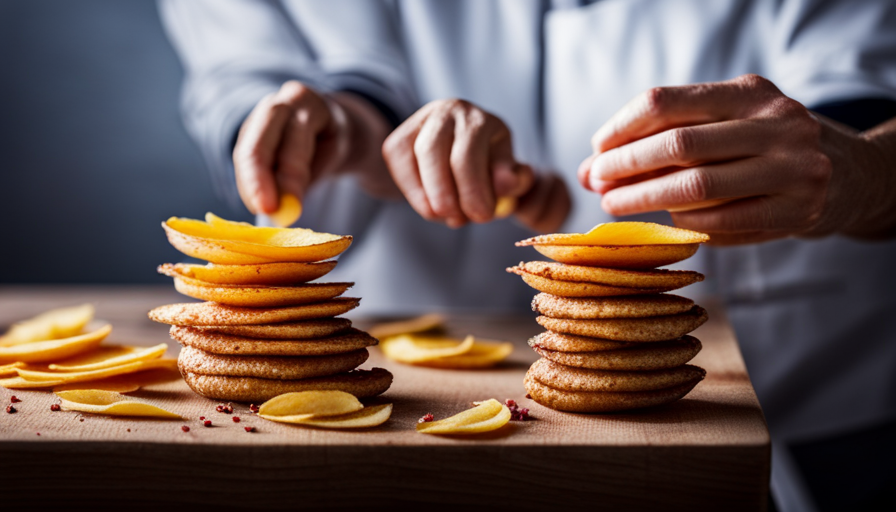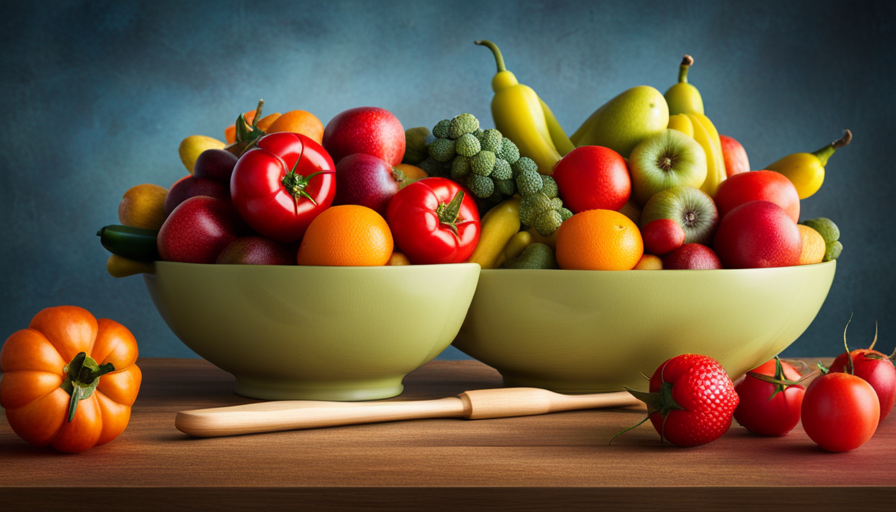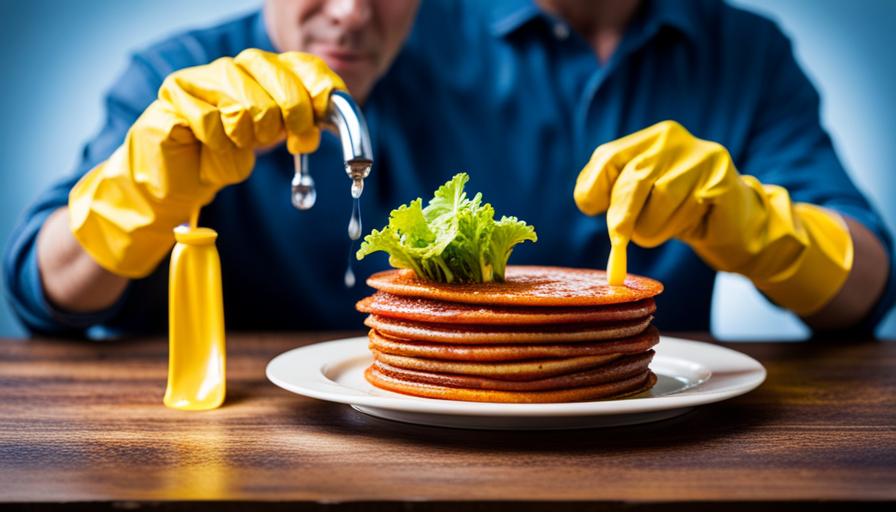Ready to elevate your raw food diet? Dehydrating potatoes is a must-try method that will bring new flavors and textures to your meals. Think of the possibilities – crispy potato chips or hearty slices for a variety of raw food recipes.
By dehydrating potatoes, you can preserve their nutritional value while enhancing their taste and texture. It’s like unlocking a world of culinary possibilities right in your own kitchen!
But where do you start? Don’t worry, we’ve got you covered. In this article, we will guide you through the process of dehydrating potatoes step by step. From selecting the right potatoes to storing the finished product, we’ll provide you with all the information and tips you need to succeed.
So grab your apron and let’s get started on this exciting journey to dehydrated potato perfection!
Key Takeaways
- Dehydrating potatoes retains their nutritional value, including vitamins C and B6, potassium, and fiber.
- Proper preparation and storage, such as washing and scrubbing the potatoes before slicing and storing them in airtight containers or vacuum-sealed bags, ensure the quality of dehydrated potatoes.
- Dehydrated potatoes can be used to make homemade potato chips or added to soups, stews, casseroles, and other dishes.
- Rehydrating dehydrated potatoes by soaking them in water or broth until soft and plump allows for various uses, such as mashing, roasting, or using them as a base for potato gnocchi or casseroles.
Choosing the Right Potatoes for Dehydration
You’ll want to make sure you’re selecting the perfect potatoes for dehydrating, so you can experience the mouthwatering taste and satisfaction of crispy, homemade potato chips on your raw food diet.
When it comes to choosing potatoes for dehydration, opting for organic varieties is highly recommended. Organic potatoes are grown without the use of synthetic pesticides and fertilizers, making them a healthier choice for your body.
There are several benefits to dehydrating potatoes for your raw food diet. Firstly, dehydrated potatoes retain most of their original nutrients, including vitamins C and B6, potassium, and fiber. This means that even in their dehydrated form, they can still provide you with essential nutrients. Additionally, dehydrated potatoes can be a great source of energy, as they contain carbohydrates that are slowly released into your body, helping to sustain your energy levels throughout the day.
When selecting organic potatoes for dehydration, look for firm and blemish-free ones. Avoid potatoes with any signs of decay or sprouting. You can choose from a variety of potato types such as Russet, Yukon Gold, or red potatoes, depending on your preference. Remember to wash and scrub the potatoes thoroughly before slicing them into thin, uniform slices for dehydration.
By choosing the right organic potatoes for dehydration, you can ensure that you’re getting the most out of your raw food diet. So go ahead and enjoy the crispy goodness of homemade potato chips guilt-free!
Preparing Potatoes for Dehydration
Get ready to experience the mouthwatering transformation of these starchy wonders as they shrink down into bite-sized, nutrient-packed morsels. When it comes to dehydrating potatoes for your raw food diet, choosing the right potatoes is key. Look for varieties like Russet, Yukon Gold, or Fingerling, as they tend to dehydrate well and maintain their flavor and texture. Avoid using new potatoes or waxy varieties, as they can become mushy during the dehydration process.
Before you begin dehydrating, it’s important to properly prepare your potatoes. Start by washing them thoroughly to remove any dirt or debris. If desired, you can peel the potatoes, but leaving the skins on can add extra fiber and nutrients. Slice the potatoes into even, thin slices, about 1/8 inch thick, to ensure they dehydrate evenly.
Once your potatoes are sliced, it’s time to dehydrate them. Arrange the slices on dehydrator trays, making sure they are not touching each other. Set the dehydrator to a temperature of around 125°F (52°C) and let them dry for 8-10 hours, or until they’re crispy and brittle.
Proper storage is crucial to maintain the quality of your dehydrated potatoes. Store them in airtight containers or vacuum-sealed bags to prevent moisture from getting in. Keep the containers in a cool, dry place away from direct sunlight.
Now that you know the proper methods for preparing and storing dehydrated potatoes, you’re ready to enjoy their convenience and nutritional benefits in your raw food diet.
Slicing Potatoes for Dehydration
Prepare to savor the irresistible transformation of these starchy delights as they effortlessly shrink down into delectable, bite-sized morsels that will leave you craving for more.
When it comes to slicing potatoes for dehydration, there are a few key techniques to ensure optimal results.
First, make sure to choose the right type of potato. Russet potatoes are a popular choice due to their high starch content, which allows for a crispier end result. Wash the potatoes thoroughly and peel them if desired.
Next, it’s time to slice. For even dehydration, aim for uniform slices that are about 1/8 inch thick. A mandoline slicer can be a handy tool for achieving consistent thickness. Alternatively, you can use a sharp knife and a steady hand.
If you prefer a more rustic texture, you can try cutting the potatoes into thin strips or even grating them. These alternative methods can create unique textures and flavors, perfect for adding variety to your dehydrated potato snacks.
Remember to arrange the slices in a single layer on your dehydrator trays to ensure even airflow and drying. Set the temperature according to your dehydrator’s instructions and let the magic happen.
In a few hours, you’ll have perfectly dehydrated potato slices ready to be enjoyed as a nutritious snack or a versatile ingredient in your raw food diet.
Blanching Potatoes Before Dehydration
Experience the mouthwatering transformation of your potatoes by blanching them before drying, leaving you with an irresistible texture that’ll have your taste buds dancing with delight.
Blanching potatoes before dehydration offers several benefits that enhance the overall quality of your dehydrated spuds. Here are three reasons why blanching is a crucial step in the process:
-
Retains color and flavor: Blanching helps preserve the vibrant color of your potatoes by halting the enzyme activity responsible for discoloration. It also helps lock in the natural flavors, ensuring that your dehydrated potatoes taste just as delicious as fresh ones.
-
Kills bacteria and enzymes: Blanching involves briefly immersing the potatoes in boiling water, which effectively eliminates any harmful bacteria present on the surface. It also deactivates enzymes that can cause spoilage during storage, extending the shelf life of your dehydrated potatoes.
-
Improves texture: By blanching, you partially cook the potatoes, resulting in a softer and more pliable texture. This makes them easier to slice and rehydrate when you’re ready to use them in your raw food recipes.
Blanching potatoes before dehydration is a simple yet crucial step that enhances the color, flavor, and texture of your dehydrated spuds. Incorporating this technique into your raw food diet will ensure that your dehydrated potatoes are both safe and delicious to consume.
Dehydrating Potatoes in a Dehydrator
Indulge in the mouthwatering aroma of perfectly dried potatoes as you savor the crispy texture and rich flavor achieved by using a dehydrator. Dehydrating potatoes in a dehydrator is a simple and effective way to preserve this versatile vegetable for your raw food diet.
First, slice the potatoes into thin, even pieces to ensure even drying. Place the slices on the dehydrator trays, making sure to leave space between each slice for proper air circulation. Set the dehydrator to a temperature between 125 and 135 degrees Fahrenheit and let it run for about 8 to 12 hours, or until the potatoes are completely dry and crisp.
Once dried, store them in an airtight container in a cool, dark place to maintain their freshness.
But what if you don’t have a dehydrator? Don’t worry, there are alternative ways to dehydrate potatoes. One option is to use your oven. Simply spread the sliced potatoes on a baking sheet and set the oven to its lowest temperature. Keep the oven door slightly ajar to allow moisture to escape and let the potatoes dry for about 4 to 6 hours, or until they’re crispy.
Another alternative is to use a food dehydrator attachment for your microwave. Follow the manufacturer’s instructions to dehydrate the potatoes using this method.
Besides being a great addition to your raw food diet, dehydrated potatoes have various alternative uses. You can use them to make homemade potato chips or add them to soups, stews, or casseroles for an extra burst of flavor and texture. They also make a delicious and nutritious snack on their own.
So, whether you have a dehydrator or not, dehydrating potatoes is a fantastic way to enjoy this staple food in a convenient and versatile form.
Dehydrating Potatoes in the Oven
If you don’t have a dehydrator, don’t worry! There are other methods you can use to dehydrate potatoes for your raw food diet.
One popular alternative is dehydrating potatoes in the oven. This method is simple and can yield excellent results if done correctly.
There are a few pros and cons to consider when dehydrating potatoes in the oven. On the positive side, using the oven allows you to dehydrate a larger batch of potatoes at once. It also ensures even heat distribution, resulting in consistent drying. Additionally, using the oven can be more energy-efficient compared to using a dehydrator.
However, there are a couple of downsides to keep in mind. First, the oven can take longer to dehydrate potatoes compared to a dehydrator. Additionally, the oven may not be as precise in temperature control, which can affect the quality of the dehydrated potatoes.
To dehydrate potatoes in the oven, start by slicing them into thin, uniform pieces. Place the slices on a baking sheet lined with parchment paper and bake at the lowest setting, around 150°F (65°C), for several hours until they are thoroughly dried. Keep an eye on them to prevent over-drying or burning.
Overall, dehydrating potatoes in the oven can be a viable option for those without a dehydrator. Just be mindful of the pros and cons and adjust your drying time and temperature accordingly.
Storing Dehydrated Potatoes
When it comes to preserving the crispy goodness of these oven-dried spuds, finding the right storage method is key. Here are four storage tips to keep your dehydrated potatoes fresh and ready for use:
-
Mason jars: Store your dehydrated potatoes in airtight mason jars to maintain their crispiness. Make sure to remove as much air as possible before sealing the jars.
-
Mylar bags: These bags are designed to keep moisture out and are perfect for storing dehydrated potatoes. Place the potatoes in the bags and use a vacuum sealer to remove the air before sealing.
-
Freezer bags: If you don’t have access to mason jars or mylar bags, freezer bags can also do the trick. Squeeze out as much air as possible before sealing the bags tightly.
-
Cool, dark place: Store your dehydrated potatoes in a cool, dark place to prevent them from absorbing moisture and losing their crunchiness.
Now that you know how to store your dehydrated potatoes properly, let’s explore some creative uses for them. You can rehydrate the potatoes by soaking them in water or broth and then use them in soups, stews, or casseroles. They also make a delicious addition to homemade potato chips or can be ground into powder to use as a seasoning. Get creative and experiment with these versatile dehydrated potatoes in your raw food diet.
Rehydrating Dehydrated Potatoes
To bring these crispy spuds back to life, simply soak them in water or broth to rehydrate and unlock their full flavor potential. Rehydrating dehydrated potatoes is a simple process that adds versatility to your cooking.
Whether you want to use them as a side dish or incorporate them into your favorite recipes, rehydrated potatoes can be a delicious addition to your raw food diet.
To rehydrate dehydrated potatoes, start by placing them in a bowl or container and covering them with enough water or broth to fully submerge them. Allow the potatoes to soak for at least 30 minutes or until they’ve absorbed enough liquid to become soft and plump. If you’re in a hurry, you can also use hot water or broth to speed up the rehydration process.
Once the potatoes are fully rehydrated, you can use them in a variety of ways. They can be mashed, roasted, or added to soups and stews. Rehydrated potatoes can also be used as a base for homemade potato gnocchi or added to casseroles for an extra burst of flavor and texture.
Using dehydrated potatoes in cooking is a convenient way to have potatoes on hand at all times. They have a long shelf life and can be easily rehydrated whenever you need them. So go ahead and experiment with rehydrated potatoes in your favorite recipes to add a tasty and nutritious element to your raw food diet.
Using Dehydrated Potatoes in Raw Food Recipes
Rehydrated spuds can truly transform your culinary creations, infusing them with a burst of texture and flavor that’ll leave your taste buds begging for more.
If you’re wondering how to use dehydrated potatoes in raw food recipes, look no further. These versatile tubers can be a game-changer in your kitchen, adding depth and substance to your dishes.
One way to incorporate dehydrated potatoes is by using them in soups. Simply soak the dehydrated potatoes in water for about 15 minutes until they’re plump and rehydrated. Then, add them to your favorite raw soup recipe for a hearty and satisfying element. The dehydrated potatoes will absorb the flavors of the soup, creating a rich and delicious base.
Another great way to use dehydrated potatoes is by incorporating them into salads. Start by rehydrating the potatoes as mentioned earlier, and then chop them into bite-sized pieces. Add them to your raw salad for a crunchy and flavorful addition. You can also mix them with other vegetables and dressings to create a unique and satisfying side dish.
So, don’t let your dehydrated potatoes go to waste. Try using them in soups and salads to elevate your raw food recipes to the next level. Your taste buds’ll thank you!
Tips and Tricks for Successful Potato Dehydration
One of the keys to successfully dehydrating potatoes is to ensure that they’re sliced evenly and thinly, allowing for a more efficient and consistent drying process. Here are some tips and tricks to help you achieve successful potato dehydration:
-
Slice the potatoes uniformly: To ensure even drying, it’s important to slice the potatoes into thin and uniform pieces. This’ll help them dry at the same rate, preventing some pieces from becoming overly dry while others remain moist.
-
Pre-treat the potatoes: Before dehydrating, you can blanch the potato slices in boiling water for a couple of minutes and then cool them in an ice bath. This helps to preserve their color and texture.
-
Properly store the dehydrated potatoes: To extend their shelf life, store the dehydrated potatoes in airtight containers or vacuum-sealed bags. Keep them in a cool, dark, and dry place to prevent moisture absorption.
-
Get creative with your dehydrated potatoes: Once you’ve dehydrated your potatoes, you can use them in various ways. They can be rehydrated and added to soups, stews, or casseroles. You can also grind them into a powder to make potato flour or use them as a crunchy topping for salads and roasted vegetables.
By following these tips, you can successfully dehydrate and store potatoes for long-term use in your raw food diet. Get creative with your dehydrated potatoes to add a nutritious and flavorful twist to your meals.
Frequently Asked Questions
Can I use any type of potatoes for dehydration?
Yes, you can use any type of potatoes for dehydration. Some popular options include russet, Yukon gold, and sweet potatoes.
Dehydrated potatoes are a great alternative to fresh ones as they have a longer shelf life and are easier to store. Additionally, they retain many of the health benefits of fresh potatoes, such as being rich in vitamins and minerals.
Dehydrated potatoes can be a convenient and nutritious addition to a raw food diet.
How thick should I slice the potatoes for dehydration?
For the best results when dehydrating potatoes for a raw food diet, it’s recommended to slice them into thin, uniform pieces. A thickness of around 1/8 to 1/4 inch works well. Thinner slices will dehydrate faster and more evenly, ensuring a crispy texture.
Thicker slices may take longer to dehydrate and may not fully dry out. Remember, the goal is to remove all moisture from the potatoes to preserve their nutritional value for your raw food diet.
Is blanching necessary before dehydrating potatoes?
Blanching isn’t necessary before dehydrating potatoes, but it can greatly enhance their quality and safety. By briefly immersing them in boiling water, you eliminate potential bacteria and enzymes that could cause spoilage or discoloration. Blanching also helps preserve the nutrients and texture of the potatoes during the dehydration process. So, although it may require an extra step, the benefits of blanching make it well worth considering for optimal results.
How long should I dehydrate potatoes in a dehydrator or oven?
To dehydrate potatoes in a dehydrator or oven, the time required will depend on various factors such as the thickness of the potato slices and the temperature used. Generally, in a dehydrator, it takes around 8-12 hours at 125-135°F, while in an oven, it may take 6-8 hours at the lowest setting.
For seasoning, options like salt, pepper, garlic powder, or even herbs like rosemary or thyme can add flavor to your dehydrated potatoes.
Can I store dehydrated potatoes in the freezer?
Yes, you can store dehydrated potatoes in the freezer! Proper storage techniques are essential for maintaining the quality of your dehydrated potatoes in a raw food diet. Freezing them in airtight containers or freezer bags will help preserve their texture and flavor for up to a year.
Incorporating dehydrated potatoes into your raw food diet has numerous benefits. They’re a great source of carbohydrates, vitamins, and minerals, and can be easily rehydrated for use in various dishes.
Can Dehydrating Potatoes Affect Their Nutritional Value for a Raw Food Diet?
Dehydrating raw potatoes with a dehydrator can slightly impact their nutritional value for a raw food diet. While dehydrating can lead to a loss of certain nutrients, the potatoes will still retain a good amount of vitamins and minerals, making them a viable option for a raw food diet.
Conclusion
In conclusion, dehydrating potatoes for a raw food diet is a simple and practical way to have a nutritious and long-lasting food source. By following the steps outlined in this article, you can easily dehydrate and store potatoes for future use.
Did you know that dehydrated potatoes can last up to 25 years when stored properly? This astonishing statistic highlights the incredible shelf life of dehydrated potatoes, making them a valuable addition to any emergency food supply.
So start dehydrating and enjoy the benefits of this versatile ingredient in your raw food recipes!










